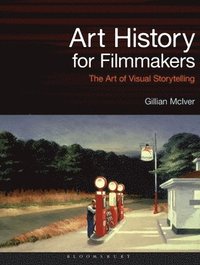
- Format
- Häftad (Paperback / softback)
- Språk
- Engelska
- Antal sidor
- 256
- Utgivningsdatum
- 2019-11-28
- Förlag
- Bloomsbury Academic USA
- Illustrationer
- 200 colour illus
- Dimensioner
- 269 x 208 x 20 mm
- Vikt
- Antal komponenter
- 1
- ISBN
- 9781501362309
- 885 g
Art History for Filmmakers
The Art of Visual Storytelling
- Skickas från oss inom 7-10 vardagar.
- Fri frakt över 249 kr för privatkunder i Sverige.
Passar bra ihop
De som köpt den här boken har ofta också köpt Knife av Salman Rushdie (inbunden).
Köp båda 2 för 774 krKundrecensioner
Fler böcker av Dr Gillian Mciver
-
Art and the Historical Film
Dr Gillian Mciver
Art and the Historical Film provides an important examination of fine art's impact on filmmaking, grappling with the question of authenticity. From Eugene Delacroixs interpretation of the 1830 French revolution to Uli Edels version of the Baa...
Recensioner i media
Excellent integration of art and film. Particularly useful in regard to cinematography and mise en scene. Ideas are well-expressed and illustrated. This text will cause filmmakers to look anew at painting. * Dr Ashley Gaskin, Institute of Technology Tralee, Ireland * This is an outstanding book for filmmakers, opening up art history and providing a visual vocabulary beyond the technically cinematic that is sure to enhance student and professional work. In taking a broad survey of art movements and linking to examples of contemporary and classic cinema, this is an approachable, essential text for film production students as well as writers and directors seeking to augment their visual knowledge. * Chris Buxton, University of Wales Trinity St David, UK * This is a nicely presented and engaging text which relates film to fine art practice in a novel and interesting way. It will be useful for students extending their practice in film making and should inspire them to consider the origins and impact of decisions in composition and lighting. * Tracy Piper-Wright, University of Chester, UK *
Övrig information
Gillian McIver studied History at the Universities of British Columbia and Toronto, and studied Film at the University of Westminster. She has curated exhibitions and ran an East London gallery. Her artist films have been screened widely, and she works as a producer and director. She has been a Visiting Lecturer at many institutions, and has taught at Roehampton University and SAE Institute London.
Innehållsförteckning
Introduction What is art history and how does it relate to cinema history?; How is art history useful for filmmakers?; Painting as a record of what the past looked like in the imagination of artists; Painting and the use of visual language; A brief linear (traditional) history of art; Towards an alternative history of art Chapter 1: Visual Culture and Storytelling Narrative and storytelling in art; Narrative in painting and cinema; Case study: William Hogarth's The Rake's Progress,and Darren Aronofsky's Requiem for a Dream; Exercise; Discussion questions Chapter 2: Creating the Visual Perspective, Colour and Lighting A brief history of perspective; Colour theory and colour psychology; How to use light; Case Study: Rembrandt, and Peter Greenaway's The Cook, the Thief, His Wife and Her Lover and Nightwatching; Exercise; Discussion questions Chapter 3: Realism in Visual Art Realism; What is representation?; Art after photography: Modern conceptions of realism in art; Case study: Johannes Vermeer, and Peter Webber's The Girl with the Pearl Earring (DoP Eduardo Serra); Exercise; Discussion questions Chapter 4: Beyond Realism Fantasy worlds in cinema and art; Oneiric: The world of dreams; Surrealism; Going beyond the real; Case study: Jack Cardiff (DoP) and A Matter of Life and Death (dir. Michael Powell and Emeric Pressburger); Exercise; Discussion questions Chapter 5: Sex and Violence Sex; Violence; Case study: Caravaggio, and Martin Scorsese's Taxi Driver ; Exercise; Discussion questions Chapter 6: Horror From dream to nightmare; Monsters; Case study: Francisco Goya, and Guillermo del Toro's Pan's Labyrinth and Pacific Rim; Exercise; Discussion questions Chapter 7: Landscape What is landscape painting?; The Western; Case study: Albert Beirstadt, Andrew Wyeth, and Ed Harris's Appaloosa. Exercise; Discussion questions Chapter 8: History and Heroism History painting: Victory, virtue, and the hero; Case study: Quentin Tarantino's Diango Unchained and Gainsborough's Blue Boy; Exercise; Discussion questions Chapter 9: Modern Movements Expressionism; Minimalism; Beyond Western culture; Case study: Katsushika Hokusai and Disney; Cinema as contemporary art; Exercise; Discussion questions Chapter 10: Conclusion - Using art history in film-making Film-making roles and art; Case study: Terrence Malick, Nestor Almendros and Andrew Wyeth (Days of Heaven); Case study: Conrad Hall, Sam Mendes and Edward Hopper (Road to Perdition); Case study: Wally Pfister, Christopher Nolan and MC Escher (Inception)


